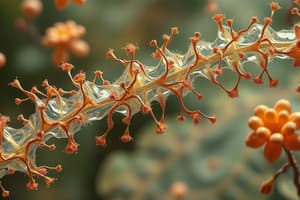Podcast
Questions and Answers
What is the term for the process in which sucrose is broken down into glucose and fructose?
What is the term for the process in which sucrose is broken down into glucose and fructose?
- Hydrolysis (correct)
- Inversion
- Dehydration Synthesis
- Polymerization
Which of the following is true about amylose?
Which of the following is true about amylose?
- It is a disaccharide.
- It consists of 70-90% amylopectin.
- It has varying chain lengths. (correct)
- It is formed by dehydration synthesis.
What is the primary function of starch in plant cells?
What is the primary function of starch in plant cells?
- Enzyme production
- Osmotic regulation
- Energy storage (correct)
- Cell wall formation
Which of the following is NOT a component of starch in plants?
Which of the following is NOT a component of starch in plants?
What is the term used for the end of a polysaccharide with an anomeric C1 not involved in a glycosidic bond?
What is the term used for the end of a polysaccharide with an anomeric C1 not involved in a glycosidic bond?
Which form of starch has molecular weights ranging from several thousands to half a million?
Which form of starch has molecular weights ranging from several thousands to half a million?
What is the most common storage polysaccharide in plants?
What is the most common storage polysaccharide in plants?
'Invert Sugar' is another term for which sugar compound?
'Invert Sugar' is another term for which sugar compound?
What color does iodine give when mixed with cellulose?
What color does iodine give when mixed with cellulose?
What type of linkages connect the glucose units in glycogen?
What type of linkages connect the glucose units in glycogen?
Which animals can digest and utilize cellulose?
Which animals can digest and utilize cellulose?
What sugar is produced upon partial hydrolysis of cellulose?
What sugar is produced upon partial hydrolysis of cellulose?
What polysaccharide is described as a major constituent of plant cell walls?
What polysaccharide is described as a major constituent of plant cell walls?
Which enzyme hydrolyzes glycogen into glucose?
Which enzyme hydrolyzes glycogen into glucose?
What type of linkages connect the glucose units in cellulose?
What type of linkages connect the glucose units in cellulose?
Study Notes
Introduction to Carbohydrates
- Carbohydrates are polyhydroxy aldehydes or ketones or compounds that yield these on hydrolysis.
- Functions:
- Sources of energy
- Intermediates in the biosynthesis of other basic biochemical entities (fats and proteins)
- Associated with other entities (glycosides, vitamins, and antibiotics)
- Form structural tissues in plants and microorganisms (cellulose, lignin, murein)
- Participate in biological transport, cell-cell recognition, activation of growth factors, and modulation of the immune system
- Classification of carbohydrates:
- Monosaccharides (e.g., glucose, fructose)
- Disaccharides (e.g., sucrose, lactose)
- Oligosaccharides
- Polysaccharides (e.g., starch, cellulose)
Monosaccharides
- Simple sugars with multiple OH groups
- Classified based on the number of carbons (3, 4, 5, 6)
- Examples:
- Triose (3 carbons): glyceraldehyde
- Tetrose (4 carbons): erythrose
- Pentose (5 carbons): ribose
- Hexose (6 carbons): glucose
Disaccharides
- Two monosaccharides covalently linked
- Examples:
- Sucrose (glucose + fructose)
- Lactose (galactose + glucose)
- Maltose (glucose + glucose)
Polysaccharides
- Polymers consisting of chains of monosaccharide or disaccharide units
- Examples:
- Starch (amylose and amylopectin)
- Cellulose
- Glycogen (animal starch)
Starch
- Composed of 20% amylose and 80% amylopectin
- Amylose: water-soluble, linear, and helical in structure
- Amylopectin: water-insoluble, highly branched, and compact in structure
Cellulose
- A major constituent of plant cell walls
- Consists of long linear chains of glucose with β(1,4) linkages
- Every other glucose is flipped over due to β linkages, promoting intra-chain and inter-chain H-bonds and van der Waals interactions
Glycogen
- Glucose storage polymer in animals
- Similar in structure to amylopectin but with more α(1,6) branches
- Stored in muscle and liver cells as granules
- Hydrolyzed by both α and β-amylases and by glycogen phosphorylase
- Gives a red-violet color with iodine
Special Monosaccharides: Amino Sugars
- Constituents of mucopolysaccharides
- Examples:
- Glucosamine
- Galactosamine
Studying That Suits You
Use AI to generate personalized quizzes and flashcards to suit your learning preferences.
Description
Test your knowledge on the definition and functions of carbohydrates in biology. Explore the role of carbohydrates as sources of energy, intermediates in biosynthesis, and structural components in plants and microorganisms.



